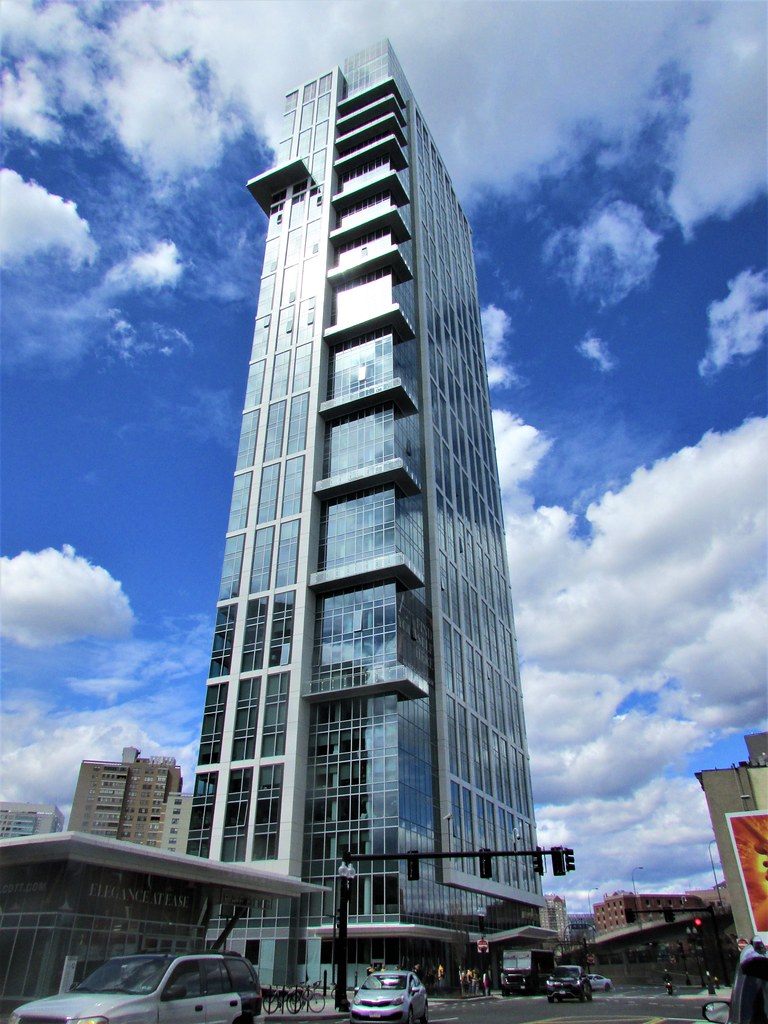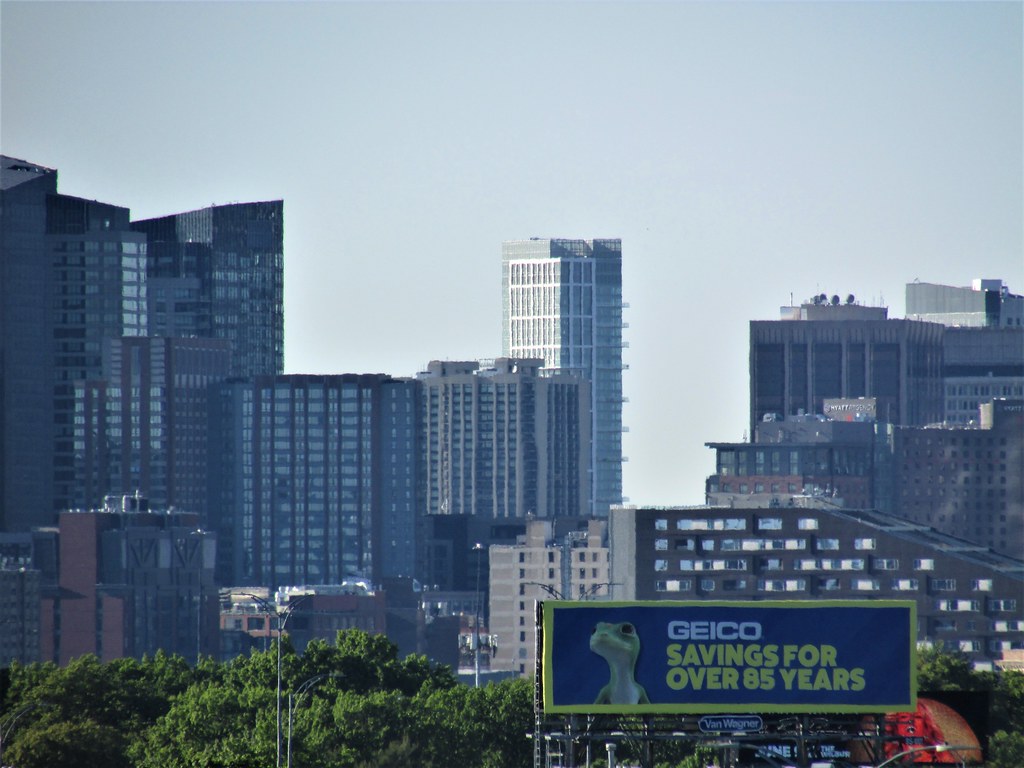The problem with this thing is the worsening of the superblock, anti pedestrian problem of the whole west end. The new promenade that goes to Lomasney is nice, but they closed the former path that connected the sidewalk where the “Best neighborhood this side of heaven” ramp is. There is a ton of foot traffic from the mgh parking lots and just coming from north station to the west end, that now forces the walker to go all the way around this building. This now extends the impassable barrier to getting into the west end even farther. You either enter at the promenade or you’ve gotta walk all the way down Martha Rd almost to Storrow just to get into the West End. It’s insane. I don’t know why they couldn’t just leave the other path, and why they don’t cut another new one on one side of the Temple. Somehow in modern design there seems to be a general sort of fake-natural, overly managed flow of pedestrian traffic that shepherds people more than necessary along paths and doesn’t simply lay out pathways based on the way people on foot like to move—which usually is 1) direct connections between points and 2) allowing multiple, redundant paths.
You are using an out of date browser. It may not display this or other websites correctly.
You should upgrade or use an alternative browser.
You should upgrade or use an alternative browser.
The Alcott (née Garden Garage Towers) | 35 Lomasney Way | West End
- Thread starter PaulC
- Start date
The problem with this thing is the worsening of the superblock, anti pedestrian problem of the whole west end.
Every time I walk through the sterile, desolate, anti-human catacombs of the West End, I reminded of the dust-jacket blurb from Mike Davis' searing indictment of LA's post-WWII culture of urban planning/policing, City of Quartz. It's basically the only thing I remember from my undergraduate instruction:
"To detractors, L.A. is a sunlit mortuary where “you can rot without feeling it.”
(Of course, that line is a gross generalization--there are certainly some neighborhoods in LA, like Westwood Village, that are inviting and attractively-scaled... but I digress.)
The modern-day West End is Boston's 'sunlit mortuary.'
All aspects of it are deadening, soul-sucking. Of course, it is especially jarring when you consider that there are several nearby, non-urban renewal-ed neighborhoods that are intensely vibrant, attractively scaled, welcoming to humans--Charles Street corridor, DTX, Bulfinch Triangle, North End. The contrast is captured with razor-sharp clarity when you consider the dichotomy between Cambridge Street's different sides--lively, inviting southside, sterile, soul-sucking, horribly-scaled northside.
Amazing quote. Given that you like that, you might appreciate Norman Mailer‘s take, the whole piece just has unreal writing:Every time I walk through the sterile, desolate, anti-human catacombs of the West End, I reminded of the dust-jacket blurb from Mike Davis' searing indictment of LA's post-WWII culture of urban planning/policing, City of Quartz. It's basically the only thing I remember from my undergraduate instruction:
"To detractors, L.A. is a sunlit mortuary where “you can rot without feeling it.”
(Of course, that line is a gross generalization--there are certainly some neighborhoods in LA, like Westwood Village, that are inviting and attractively-scaled... but I digress.)
The modern-day West End is Boston's 'sunlit mortuary.'
All aspects of it are deadening, soul-sucking. Of course, it is especially jarring when you consider that there are several nearby, non-urban renewal-ed neighborhoods that are intensely vibrant, attractively scaled, welcoming to humans--Charles Street corridor, DTX, Bulfinch Triangle, North End. The contrast is captured with razor-sharpclarity when you consider the dichotomy between Cambridge Street's different sides--lively, inviting southside, sterile, soul-sucking, horribly-scaled northside.
(from www.esquire.com/news-politics/a3858/superman-supermarket/)
Seeing Los Angeles after ten years away, one realizes all over again that America is an unhappy contract between the East (that Faustian thrust of a most determined human will which reaches up and out above the eye into the skyscrapers of New York) and those flat lands of compromise and mediocre self-expression, those endless half-pretty repetitive small towns of the Middle and the West whose spirit is forever horizontal and whose marrow comes to rendezvous in the pastel monotonies of Los Angeles architecture.
So far as America has a history, one can see it in the severe heights of New York City, in the glare from the Pittsburgh mills, by the color in the brick of Louisburg Square, along the knotted greedy facades of the small mansions on Chicago's North Side, in Natchez' antebellum homes, the wrought-iron balconies off Bourbon Street, a captain's house in Nantucket, by the curve of Commercial Street in Provincetown. One can make a list; it is probably finite. What culture we have made and what history has collected to it can be found in those few hard examples of an architecture which came to its artistic term, was born, lived and so collected some history about it. Not all the roots of American life are uprooted, but almost all, and the spirit of the supermarket, that homogeneous extension of stainless surfaces and psychoanalyzed people, packaged commodities and ranch homes, interchangeable, geographically unrecognizable, that essence of a new postwar SuperAmerica is found nowhere so perfectly as in Los Angeles' ubiquitous acres. One gets the impression that people come to Los Angeles in order to divorce themselves from the past, here to live or try to live in the rootless pleasure world of an adult child. One knows that if the cities of the world were destroyed by a new war, the architecture of the rebuilding would create a landscape which looked, subject to specifications of climate, exactly and entirely like the San Fernando Valley.
It is not that Los Angeles is altogether hideous, it is even by degrees pleasant, but for an Easterner there is never any salt in the wind; it is like Mexican cooking without chile, or Chinese egg rolls missing their mustard; as one travels through the endless repetitions of that city which is the capital of suburbia with its milky pinks, its washed-out oranges, its tainted lime-yellows of pastel on one pretty little architectural monstrosity after another, the colors not intense enough, the styles never pure, and never sufficiently impure to collide on the eye, one conceives the people who live here—they have come out to express themselves, Los Angeles is the home of self-expression, but the artists are middle-class and middling-minded; no passions will calcify here for years in the gloom to be revealed a decade later as the tessellations of hard and fertile work, no, it is all open, promiscuous, borrowed, half bought, a city without iron, eschewing wood, a kingdom of stucco, the playground for mass men—one has the feeling it was built by television sets giving orders to men. And in this land of the pretty-pretty, the virility is in the barbarisms, the vulgarities, it is in the huge billboards, the screamers of the neon lighting, the shouting farm-utensil colors of the gas stations and monster drugstores, it is in the swing of the sports cars, hot rods, convertibles, Los Angeles is a city to drive in, the boulevards are wide, the traffic is nervous and fast, the radio stations play bouncing, blooping, rippling tunes, one digs the pop in a pop tune, no one of character would make love by it but the sound is good for swinging a car, electronic guitars and Hawaiian harps.
Patrick Winn
Active Member
- Joined
- Aug 19, 2020
- Messages
- 256
- Reaction score
- 519
What is the "superblock?"Every time I walk through the sterile, desolate, anti-human catacombs of the West End, I reminded of the dust-jacket blurb from Mike Davis' searing indictment of LA's post-WWII culture of urban planning/policing, City of Quartz. It's basically the only thing I remember from my undergraduate instruction:
"To detractors, L.A. is a sunlit mortuary where “you can rot without feeling it.”
(Of course, that line is a gross generalization--there are certainly some neighborhoods in LA, like Westwood Village, that are inviting and attractively-scaled... but I digress.)
The modern-day West End is Boston's 'sunlit mortuary.'
All aspects of it are deadening, soul-sucking. Of course, it is especially jarring when you consider that there are several nearby, non-urban renewal-ed neighborhoods that are intensely vibrant, attractively scaled, welcoming to humans--Charles Street corridor, DTX, Bulfinch Triangle, North End. The contrast is captured with razor-sharp clarity when you consider the dichotomy between Cambridge Street's different sides--lively, inviting southside, sterile, soul-sucking, horribly-scaled northside.
but they closed the former path that connected the sidewalk where the “Best neighborhood this side of heaven” ramp is
I'm having trouble picturing this. Are you referring to the path that passed the former tennis courts and garage, or something else?
Yes, they removed the previous path on the right side of the front of the building and replaced with the larger path on the left side of the front of the building.I'm having trouble picturing this. Are you referring to the path that passed the former tennis courts and garage, or something else?
atlantaden
Senior Member
- Joined
- May 31, 2006
- Messages
- 2,602
- Reaction score
- 2,726
Nibbles O’Plenty
Active Member
- Joined
- Aug 24, 2020
- Messages
- 213
- Reaction score
- 738
It’s rear end is much nicer than the old garage offered.


6/9 From Waltham. I definitely think it's the best out of the 4, followed by Verizon. Does anybody know what the deal is with the large solitary balcony on the right side? I'm not a fan of balconies that stick out like that. It always scares me that they might just fall off while I'm standing on them, although it hasn't happened yet! Honestly though, with the wind levels what they are a couple hundred feet off the ground, I'm not sure why anybody would want a balcony that high.
 IMG_1763 by David Z, on Flickr
IMG_1763 by David Z, on Flickr
 IMG_1763 by David Z, on Flickr
IMG_1763 by David Z, on Flickr
 IMG_9445
IMG_9445 IMG_9472
IMG_9472 IMG_9877
IMG_9877 IMG_9881
IMG_9881 IMG_9882
IMG_9882 IMG_9916
IMG_9916 IMG_0452
IMG_0452 IMG_0660
IMG_0660
 IMG_1286
IMG_1286 IMG_1287
IMG_1287 IMG_1359
IMG_1359 IMG_1384
IMG_1384 IMG_1475
IMG_1475 IMG_1476
IMG_1476